Creative 3D Blaster PCI
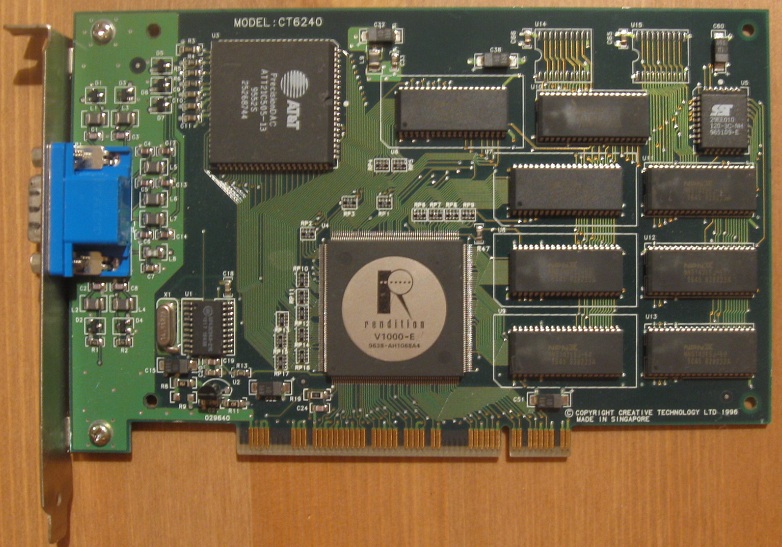
Proof of Rendition's momentum is Creative's surprising divorce with 3Dlabs. For new 3D Blaster they picked V1000 and prepared for it some old and new CGL games. But the most anticipated part of the bundle was certainly floppy with VQuake, first hardware accelerated version of Id Software's first truly 3d game. Thanks to CGL and Speedy3D V1000 had almost 20 3d games ready upon launch. V1000E runs at 50 MHz synchronously with EDO DRAM. You can see Vérité 1000 needs external clock generator and ramdac, so there were still reserves in integration.
Canopus Total3D
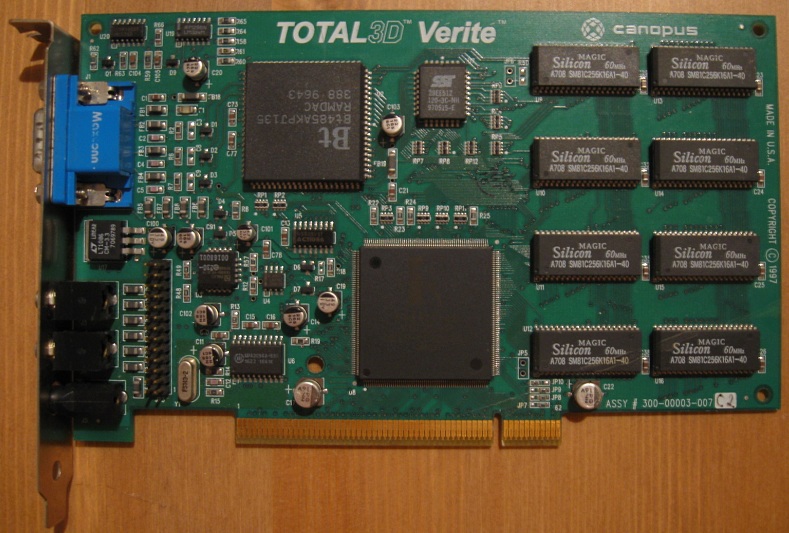
At the end of the year Rendition produced lower powered version of V1000. It allowed for 20% percent faster clocks and Canopus was first to use it for their board with stereo 3d rendering support. The later graphics chip revision is marked V1000L-P, old 5 Volt logic was replaced with 3.3V. This was the first Vérité I tested. Since Canopus claimed 30 Mpixel/s fillrates and memory is rated for 60 MHz, it is a safe bet to expect same chip clock. It might still not be the fastest board, Miro's VRX for example had 35ns DRAM. Problem is I did not find any tool capable detecting or changing clocks. All V1000 cards carry 4 MB of EDO RAM connected through 64 bit bus, at 60 MHz should provide 500 MB/s peak bandwidth. V1000 does not behave as particularly bandwidth efficient card and significantly slows down in depth buffered and heavily alpha blended scenes. Whether it is caused by the architecture or little memory bandwidth I dare not to guess. Vérité was made mainly for 3d gaming and did not aim at high resolutions, 135 MHz ramdac would not let it anyway. 100 Hz at 640x480 might seem enough, but do not forget a board with stereo 3D rendering like this Total3D needs double the usual refresh. Stability can be an achilles heel of Vérité. V1000 features asynchronous DMA engine minimizing CPU interruptions, but it caused some compatibility issues. In case of problems disable any write combining and make sure your motherboard handles DMA properly. Even then, you may experience more lock ups than with any other board. The built-in CPU stores its code in local memory and any improper write to that area means game over and pushing reset. Rendition calls the CPU code a microcode, but firmware is a more appropriate name.
Inside V1000
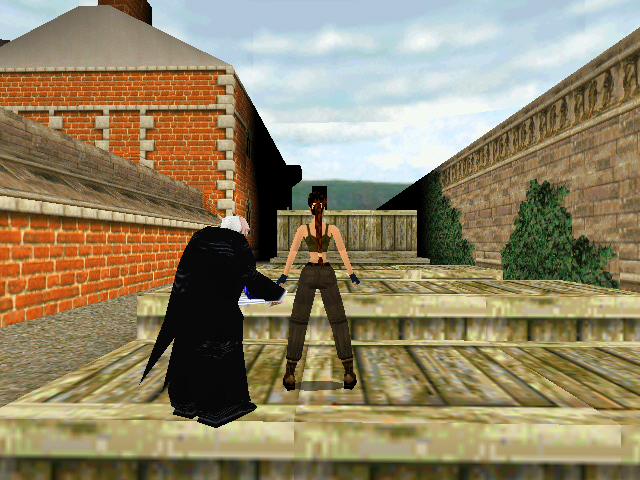 Polygon seams? Not over Rendition's four bit sub pixel precision
Polygon seams? Not over Rendition's four bit sub pixel precisionV1000 is a single chip 3d graphics engine, GUI and video accelerator. Besides discrete cards Rendition hoped for motherboard integration, but that did not happen. The Vérité supports all the basic texture mapping with true perspective correction, bilinear filtering with texel caching for single pass operation, per polygon mip-mapping, z-buffering, fog and all blending modes needed for 3d games. 4 bit texture palettes are built in external ramdac. Two cycles are needed for scanline conversion. Gouraud shading isn't the nicest, but further in the pipeline V1000 gains image quality points for color accuracy and 4 bit sub pixel/texel precision. Texturing is expensive adding 1-2 cycles and z-buffering has the same impact. The final image is gently dithered down into 16 bit colors, however, at least in OpenGL true colors are possible. Additionally V1000 also offered edge antialiasing and whatever features made possible by programmable RISC CPU in front of the hardwired pixel pipeline. The CPU is a MIPS-like architecture and besides issuing commands for the pixel pipeline, it is typically used for triangle setup performed at rate of 20 cycles per attribute. The point of programmability might not have been more freedom for developers, but rather a way to improve silicon efficiency. Rarely used operations which would otherwise require own stages in classic graphics pipeline can be handled by the RISC unit. Heterogeneous design of Vérité brings other peculiar specifics. From the local video memory 128 kB is reserved for firmware. Those are the *.uc files coming with games supporting Rendition. The Vérité was criticized for slow VGA drawing, but it's VESA performance is great and Rendition delivered tool to convert old modes. Also Windows GUI speed is acceptable to me. V1000 even provides color space conversion and image scaling with bilinear interpolation to assist digital video. Antialiasing is something gamers got used to much later, what could this 1996 chip do?
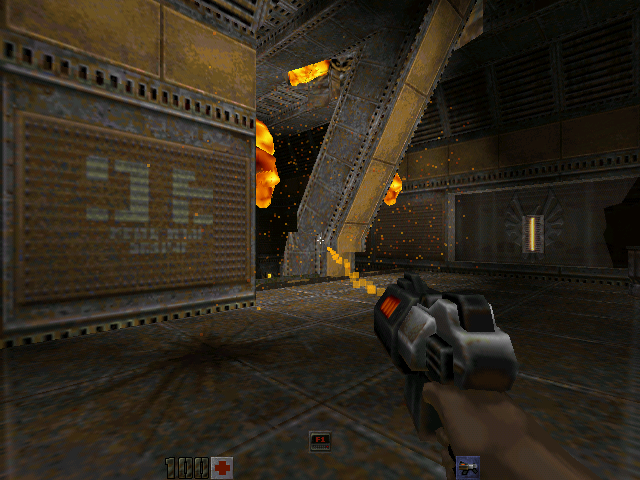 Click on the image to see VQuake 2 with maxed AA.
Click on the image to see VQuake 2 with maxed AA.I could've chosen a better scene for demonstration, but one shouldn't expect as much work from edge antialiasing as from full-scene techniques. This filter smoothens transitions between the edges of selected polygons and cannot affect intersecting polygons. Several other architectures from this generation supported Edge AA as well, but I doubt they could come close to the speed of Vérité. Beside edge AA you can see also monochrome lightmaps, one of the reasons VQuake 2 performs much better than GLQuake. There are seven settings for edge antialiasing to cover all combinations of three sorts of polygons: world, objects and particles. For my AA test the maximum value 7 is used. Ïn theory V1000 can output 3D textured pixel every second clock, but with all the 3D features used real world fillrates are lagging behind. Notably Z-buffering was supposedly not expected as a necessity during development and was later implemented with difficulties. I run few games without hardware depth buffering and got around 50% higher speed.
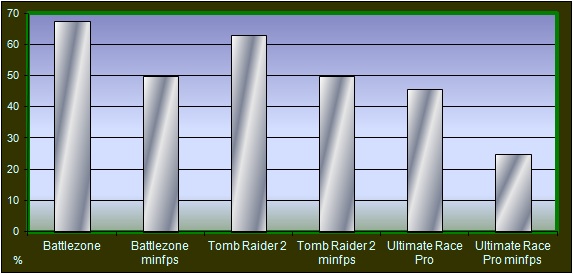
Vérité can do well with weak CPUs thanks to full triangle setup. I really need to finish my slow super socket 7 rig. VQuake framerates are so high because the engine is doing hidden surface removal of the world in software, leaving Vérité less pixels to draw and little depth buffering of other objects.
Experience
From a compatibility view V1000 did well in my selection. There were only two total losses, one being Motoracer 2, where I couldn't get over incorrect VRAM amount error. Second is Unreal failing under d3d with infamous "oversized texture without mipmaps" error and I could not get OpenGL renderer to perform texturing. Falcon 4.0 does not recognize Vérité as 3D accelerator, but after disabling the limitation via registry it runs just fine. Then there were tests which I at first could not complete because of my V1000L-P instability: Revshogo and Viper Racing. Granted, there were many lock ups in more games, but eventually I finished them properly. Only after Creative 6240 testing I saw V1000 operating reliably. Perhaps my Total3D has hardware issues. To see how good games look head to the V1000 gallery. As for image quality only big troubles were seen in Shogo and Thief, both games suffer from lightmap z-fighting. I am sure the compatibility skydived since 1999, but longevity of first Vérité is respectable. Just don't expect 640x480 gaming. CGL compatibility seems to be question of single library, but executables for 3D Blaster are checking for Creative brand. The CT6240 or faster 6260 are the easiest way into CGL titles. There is an OpenGL ICD for Vérité 2 which is at once unsupported beta V1000 ICD. And it works with more than Quake engine, although it still fails in many games like Return Fire 2, Starsiege for example works with minor glitches. Watching reasonably rendered Quake 3 on V1000 makes me appreciate the driver effort behind it.
 Click for 32 bit depth screenshot.
Click for 32 bit depth screenshot.
Performance
Rendition was tuning bios of V1000 for quite some time. Update may provide significant improvements, for all my tests was used latest 2.105 version via TSR loader. For all the other games V1000 produced usually admirably high image quality. It is Speedy3D/RRedline games that are offering an interesting alternative. First GLQuake performs better with ICD than gold minigl, but it is still not even half of speed of VQuake. The Vérité port is heavily optimized and does not use all features of the chip, leaving more work for the CPU. Even Quake 2 has Vérité port, albeit beta. Same situation repeats here, Proprietary renderer with single pass monochrome lighting and maxed out antialiasing runs way faster than OpenGL two pass colored lighting.
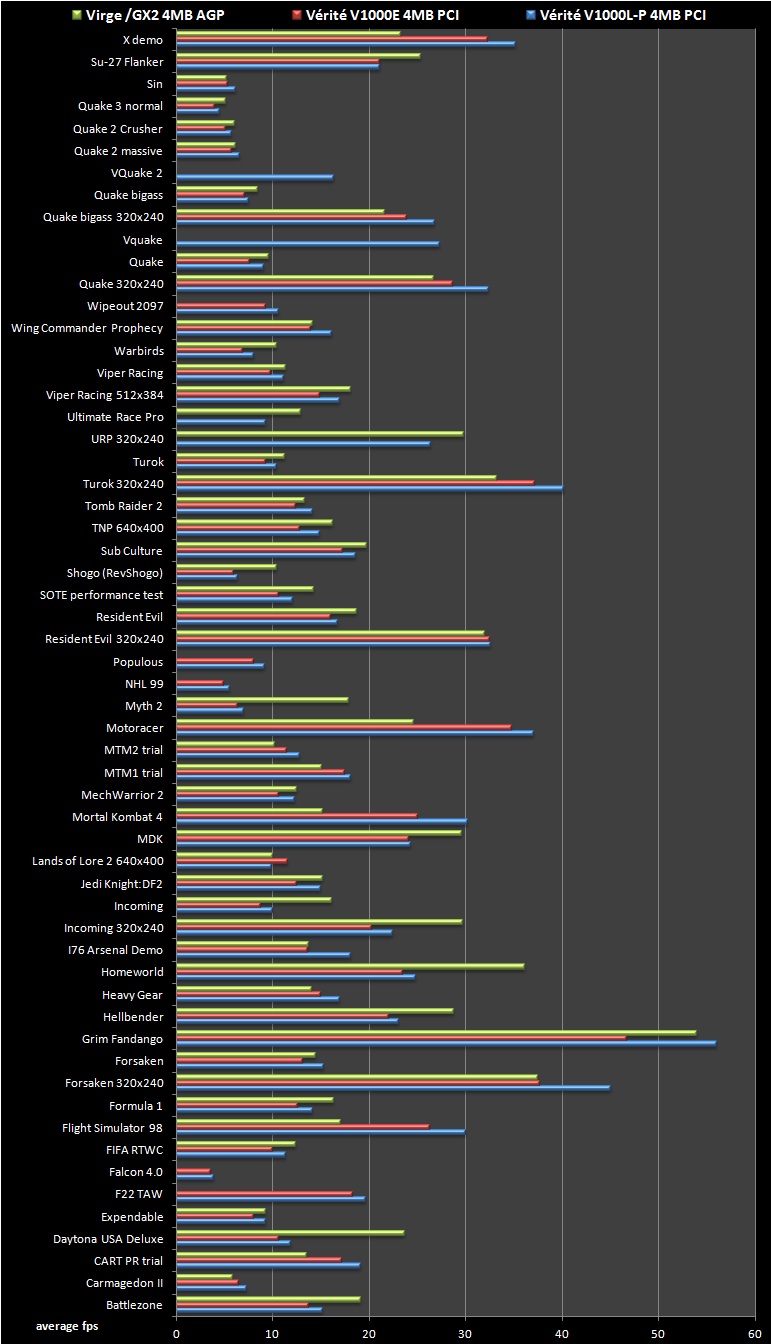
Canopus Total3D fall short of average framerates of Virge /GX2 by 7% and the gap widens at minimal framerates. However, since V1000 provides higher precision rendering with all features old games could demand, I still consider this card a bit more powerful hardware. I guess most of people don't want to see a comparison with some stinky Virge, but Voodoo. Just in numbers: at 640x480 I calculated this V1000L-P to be 46% of Voodoo performance overall, were OpenGL Quake games are significantly lower at 33% however VQuakes are running at 75%-95% of Voodoo. Old V1000E is trailing behind V1000L-P by 10-15%. It is obvious why Vérité had to be a budget solution. There isn't enough fillrate for 640x480, but the saving grace is good scaling with lowered resolutions.
Losing ground
Too bad for Rendition they could not get the chip out earlier in the year, they could gain more mindshare. V1000 halo went away quickly after Voodoo fame arise, but that is pretty much only bad thing I could say. Well except the potential instability, developers did not like dealing with DMA transfers either. Everyone fell prey to the blazing speed of 3dfx, but only Vérité competed with it in features, image quality and compatibility. For roughly half the price of Voodoo Vérité offered 2D, full triangle setup, a fair number of Rendition ports with special features like edge antialiasing at reasonable speed. There could have been even more if Rendition had own API for Windows 95 ready before 1997. V1000 beats all other pre-Voodoo value accelerators hands down, even if possibilities of it's RISC core might not have been fully exploited. V1000 lost ambitions too quickly to push developers away from classic rendering concepts. Nevertheless Vérité was a great choice for gamers on a tight budget, with slower CPUs, who wanted to experience full featured 3D acceleration, but not necessarily at high resolutions. One year later Rendition released much improved second Vérité.